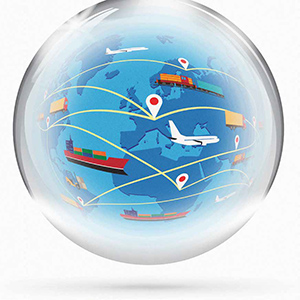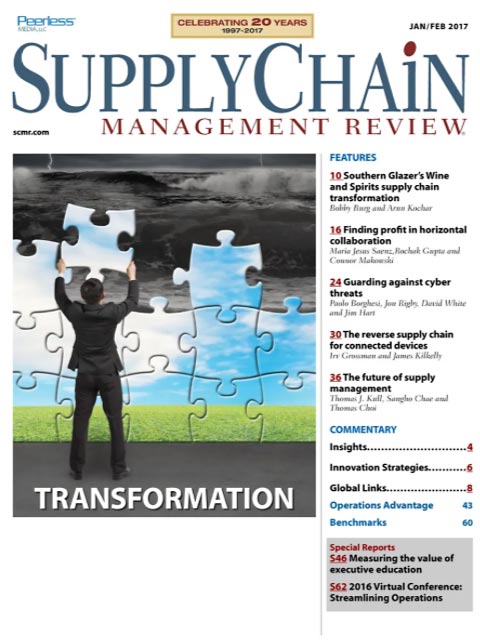Sorry, but your login has failed. Please recheck your login information and resubmit. If your subscription has expired, renew here.
January-February 2017
Transformation is a topic that comes up in almost every conversation I have with supply chain managers these days. Executives from companies as diverse as J&J Vision Care, the division of Johnson & Johnson that manufactures contact lenses, and Thrive Markets, a startup selling health and wellness products to its members, have talked about how they have had to remake their supply chains to meet new customer demands. Transformation is also the theme of this issue of SCMR. Browse this issue archive.Need Help? Contact customer service 847-559-7581 More options
When it comes to predicting the future, we’ve all heard the sayings that no one has a crystal ball and that the only certainties are death and taxes. In supply chain management, we like to say that the only thing certain about a forecast is that it is always wrong. While researchers like those of us at CAPS Research may not be able to predict the future, we do know that it does not exist in isolation: It depends on the past and the present. This means that if we could compile the collective projections of managers who are well informed about the past and present, we might be able to gain a glimpse into what is to come. Or, at the least, what the collective wisdom expects to occur.
That was the catalyst behind a project CAPS Research initiated in 2015. We asked more than 400 supply management professionals with titles such as vice president of supply management and senior procurement manager to look ahead five years into the future to 2020 and tell us what they think might happen. We distributed a lengthy questionnaire that typically took about 30 minutes to complete and we received back 113 responses. There were no incentives other than the opportunity to advance the body of knowledge in the profession.
In order to consider both the past and the present, the 2015 survey built upon the last “futures” survey CAPS Research administered in 2007. While some items were updated to reflect today’s business environment, most of the items remained the same. The preliminary framework (See Figure 1) recognizes that external forces of change drive corporate-level business strategies while supply missions are shaped by business strategies. Specific supply strategies are influenced by forces of change, business strategies and supply missions.

This complete article is available to subscribers only.
Log in now for full access or start your PLUS+ subscription for instant access.
SC
MR
Sorry, but your login has failed. Please recheck your login information and resubmit. If your subscription has expired, renew here.
January-February 2017
Transformation is a topic that comes up in almost every conversation I have with supply chain managers these days. Executives from companies as diverse as J&J Vision Care, the division of Johnson & Johnson… Browse this issue archive. Access your online digital edition. Download a PDF file of the January-February 2017 issue.When it comes to predicting the future, we've all heard the sayings that no one has a crystal ball and that the only certainties are death and taxes. In supply chain management, we like to say that the only thing certain about a forecast is that it is always wrong. While researchers like those of us at CAPS Research may not be able to predict the future, we do know that it does not exist in isolation: It depends on the past and the present. This means that if we could compile the collective projections of managers who are well informed about the past and present, we might be able to gain a glimpse into what is to come. Or, at the least, what the collective wisdom expects to occur.
That was the catalyst behind a project CAPS Research initiated in 2015. We asked more than 400 supply management professionals with titles such as vice president of supply management and senior procurement manager to look ahead five years into the future to 2020 and tell us what they think might happen. We distributed a lengthy questionnaire that typically took about 30 minutes to complete and we received back 113 responses. There were no incentives other than the opportunity to advance the body of knowledge in the profession.
In order to consider both the past and the present, the 2015 survey built upon the last “futures” survey CAPS Research administered in 2007. While some items were updated to reflect today's business environment, most of the items remained the same. The preliminary framework (See Figure 1) recognizes that external forces of change drive corporate-level business strategies while supply missions are shaped by business strategies. Specific supply strategies are influenced by forces of change, business strategies and supply missions.
SC
MR


Latest Supply Chain News
- How CPG brands can deliver on supplier diversity promises
- How S&OP provides the answer to in-demand products
- AI, virtual reality is bringing experiential learning into the modern age
- Humanoid robots’ place in an intralogistics smart robot strategy
- Tips for CIOs to overcome technology talent acquisition troubles
- More News
Latest Podcast

 Explore
Explore
Latest Supply Chain News
- How CPG brands can deliver on supplier diversity promises
- How S&OP provides the answer to in-demand products
- AI, virtual reality is bringing experiential learning into the modern age
- Humanoid robots’ place in an intralogistics smart robot strategy
- Tips for CIOs to overcome technology talent acquisition troubles
- There is still work to do to achieve supply chain stability
- More latest news
Latest Resources

Subscribe

Supply Chain Management Review delivers the best industry content.

Editors’ Picks





